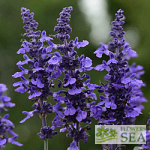(White Flame Sage) Like bright white candle flames, the short vigorously upright flower spikes of petite Salvia x 'White Flame' light up flower beds. Its medium-size, mid-green leaves are fragrant, fuzzy, and striped with thin parallel veins.
White flame is a fine choice for container plantings and mixed borders in full sun to partial shade settings. It's heat tolerant, needs only average watering based on local rainfall, and well-drained soil. It's long blooming, so you can expect plenty of bee and butterfly visits from summer until the end of the growing season. As with so many Salvias, deer tend to avoid it.
Ball Horticultural plant breeder Gail Shafer hybridized White Flame Sage in 2016. The company notes that despite the color of its flowers, White Flame is "most similar in comparison" to their Rockin® series hybrid Salvia 'Playin' the Blues'. That sage has violet-blue flowers and is also known as Mystic Spires Improved.
Continuing along this trail of genetic heritage, Mystic Spires is a relative of Huntington Gardens' famous 1970s sage Indigo Spires, which is an accidental hybrid of Mexican Sage (Salvia longispicata) and the American native Mealycup Sage (Salvia farinacea).


